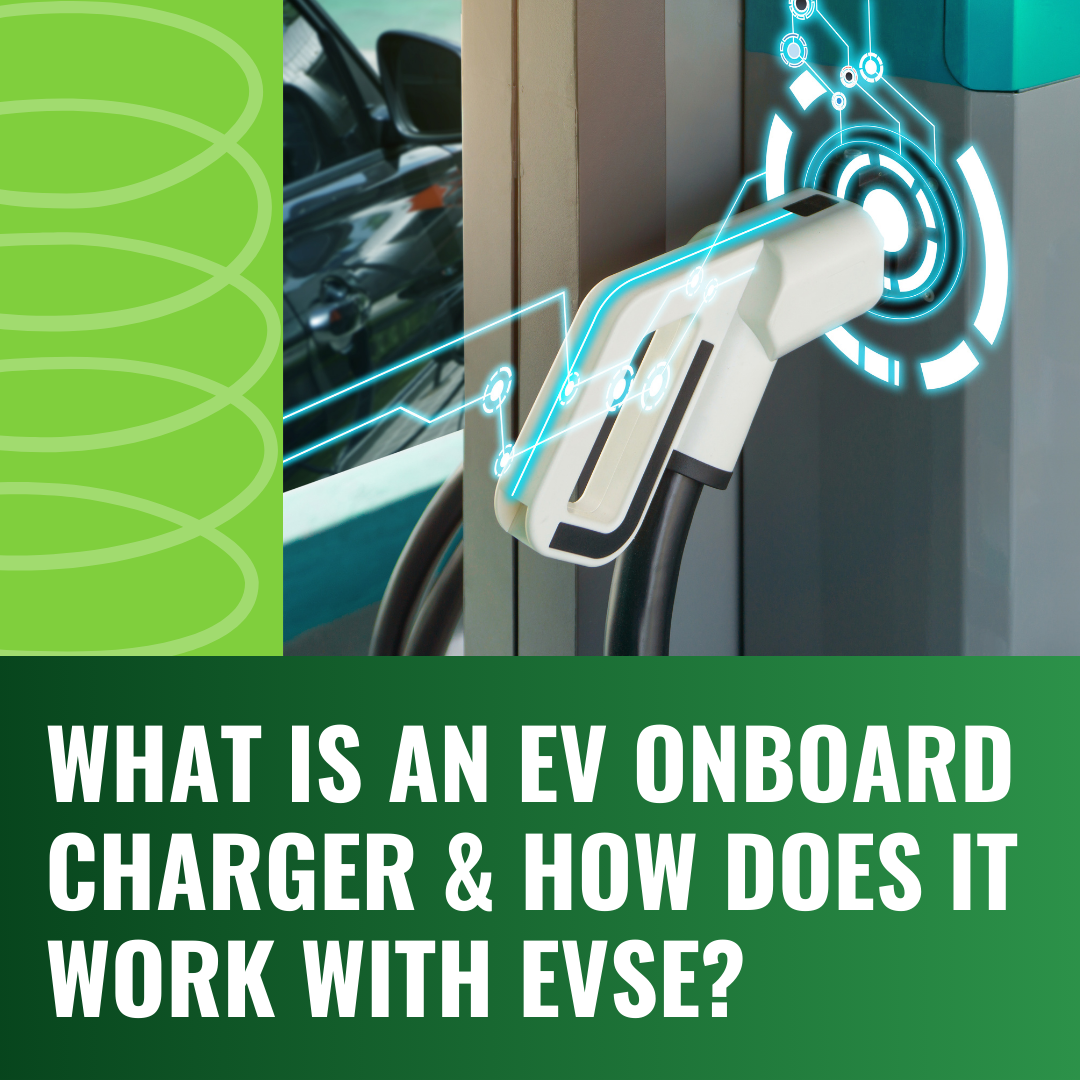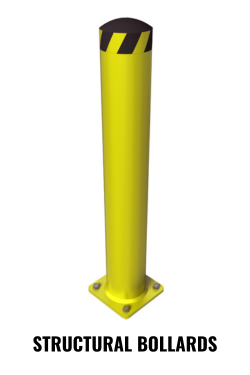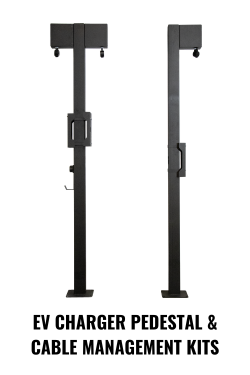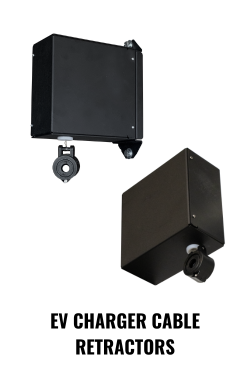We use cookies to make your experience better. To comply with the new e-Privacy directive, we need to ask for your consent to set the cookies. Learn more.
What Is an EV Onboard Charger and How Does It Work With EVSE?
Electric vehicle (EV) chargers aren’t what you think. Technically, they aren’t chargers at all. A battery charger introduces electrical current directly to the battery. 
The Level 2 charger you set up to resupply your EV fleet doesn’t do this, not exactly. External EV chargers require an intermediary to supply power to batteries. The device that sits between the external power unit and the battery is called an EV onboard charger. That’s sometimes abbreviated as OBC.
To be clear, the external EV charger doesn’t supply the battery. It supplies the OBC, and the OBC supplies the battery. That’s why EV engineers don’t call external EV chargers “EV chargers.” They call them electric vehicle supply equipment (EVSE).
The role of that EVSE is to deliver electricity that the OBC uses to charge the EV battery. So what’s the difference? Why do we need both external EVSE and onboard chargers?
Here are answers to these questions and more — plus expert advice on setting up your EVSE stations.
EV Onboard Chargers and EVSE: Frequently Asked Questions
1. What is an EV onboard charger?
Here’s a simple definition of onboard chargers for electric vehicle batteries:
An EV onboard charger is an electronic device that regulates voltage while converting alternating current (AC) to direct current (DC) power for the purpose of charging an EV battery.
As the name implies, an onboard charger is built into the vehicle’s power system. It’s not meant to be removed regularly, although they can be replaced by skilled EV mechanics.
2. Why is the AC to DC power conversion necessary?
There’s a mismatch between the electricity that flows through the power grid and the electricity your EV battery uses to power your vehicle. The OBC bridges the gap.
Electric vehicle batteries store and discharge energy as DC power, while external EV charging equipment supplies AC power.
That’s because the power grid transfers alternating current, which can travel in high voltages across long distances, then get stepped down to a usable voltage at local transformer stations. Direct current can’t do the same — but it delivers the steady, continuous voltage batteries need for safe recharging.
This combination of systems requires an electronic device that handles the conversion. Usually that’s the OBC. But with DC fast charge technology — the quickest of all EVSE — the AC-to-DC conversion happens before current reaches your vehicle.
3. How do onboard chargers work with DC fast charge technology?
If the OBC’s main job is to convert AC to DC power, what does that mean when you deliver DC power in the first place?
Before we get into the answer, we should review the three EV charging levels you might employ in your fleet EVSE:
- Level 1 EVSE draws power from standard, 120-volt wall outlets. It’s the slowest type of EV charging, taking up to two full days to charge a 60 kWh battery from zero to 80 percent state of charge (SoC).
- Level 2 EVSE draws power from 208 or 240-volt outlets. It’s also the most common type of EVSE for commercial EV fleets, due to its relative low cost and high utility. Level 2 charging stations can take a 60kWh EV battery from zero to 80 percent SoC in as few as four hours.
- Level 3 (DC Fast Charge) EVSE draws up to 1,000 volts DC power, making it the fastest of all EVSE technologies. It can get your EV battery to 80 percent SoC in as few as 20 minutes.
One of the reasons DC Fast Charge moves so quickly is that there’s no conversion from AC to DC necessary — or, more accurately, the external EVSE completes that conversion before power enters the EV’s power system.
When you charge an EV with Level 3 EVSE, the current bypasses the OBC entirely. It sends DC power directly to the battery.
4. What else does an onboard charger do?
While the primary purpose of the OBC is to convert AC to DC power, these devices also manage the charging process. Integrated OBC computers communicate with EVSE to ensure the appropriate voltage, charging limits, and other technical specifications for the battery.
Because of this control, the OBC is what limits charge speed, not the charging station. Each battery/OBC system has a maximum charging rate, or power rating, which limits how fast the battery can charge.
The most common power rating is 7 kilowatts (kW), although commercial vehicles may use 11 kW or even 22 kW OBCs, too.
A Level 2 charger may deliver continuous power at over 19 kW — but the OBC will limit this to match its power rating. That means you can’t predict charge times based on the EVSE output alone; you’re better off referring to your OBC’s power rating.
5. What equipment do you need to build an EV charging station?
Fleet-charging stations require a lot of EVSE, with an optimal mix of Level 2 and Level 3 technologies. That mix will differ for every business.
It might be nice to install DC Fast Charge stations exclusively, but that’s too expensive for most businesses. Here are the comparative cost breakdowns for Level 2 EVSE versus DC Fast Charge EVSE, according to the U.S. Department of Energy’s Energy Efficiency & Renewable Energy (EERE) division:
- Level 2 EVSE: $400 to $6,500 per port
- DC Fast Charge EVSE: $10,000 to $40,000 per port
Given those prices, we’ll assume you’re building mostly Level 2 charging stations. That makes a difference in the equipment you’ll need, because DC Fast Charge equipment is usually built into an enclosure. Level 2 chargers must typically be mounted onto walls or EV charger stands.
That makes your minimum EVSE infrastructure include the following items:
- EV Charger Pedestals. The ideal EV charger stand protects EVSE by posting it at least 18 inches (450 millimeters) off the ground indoors, or 24 inches (600 millimeters) outdoors. (These height requirements come from the National Electrical Code® Article 625).
Buy EV Charger Pedestals from Solus Group.
- Cable Management Systems. Charging cables connect EVSE to your car’s charging port, which interfaces with the OBC. Those charging cables are vulnerable to damage and expensive to replace — and they can be awkward to handle. EV Charger Cable Retractors automatically lift cables out of the way between uses, and can be mounted onto walls or pedestals.
Buy EV Charger Cable Retractors from Solus Group.
- Structural Bollards. Protect charger installations from vehicle strikes with powerful steel Structural Bollards. These barriers can be bolted into floors or parking lots to keep vehicles at a safe distance from ESVE.

Save space in your EV charging depot by mounting two Level 2 chargers to a single pedestal. You can also simplify your installations with pre-integrated EV Charger Pedestal and Cable Management Kits.
These steel, powder-coated EVSE stands take up a minimal footprint and are suitable for indoor and outdoor use. They include adjustable mounts for one or two Level 2 chargers, plus attached Cable Management Reels, making them the ideal solution for fleet charging stations.
All of these solutions are designed for common Level 2 chargers, including those with high output capabilities. For the fastest Level 2 charging, look for onboard chargers with power ratings of 11 or even 22 kW — and select Level 2 chargers with similar output.
To learn more about EV Charger Handling equipment for fleet-charging depots, contact the experts at Solus Group by calling 314-696-0200 today.


